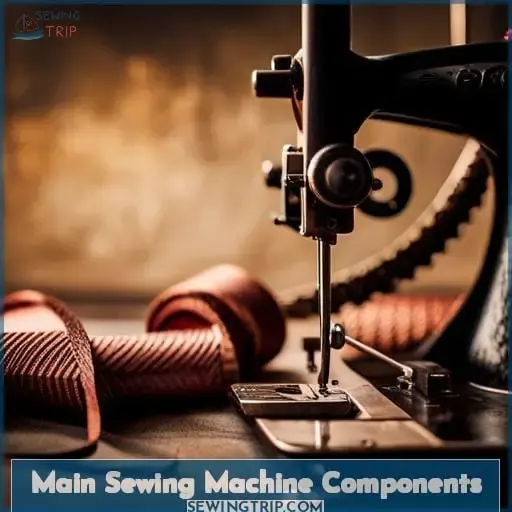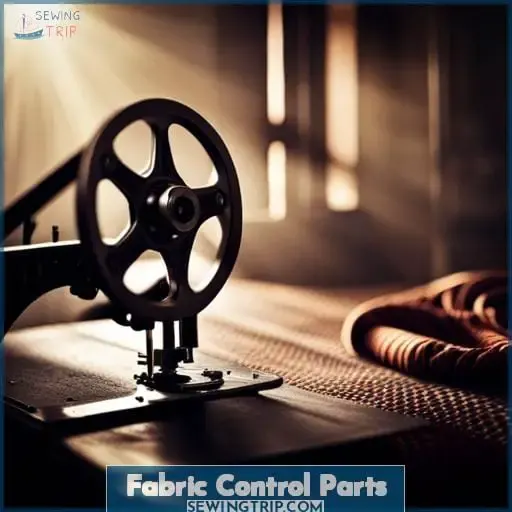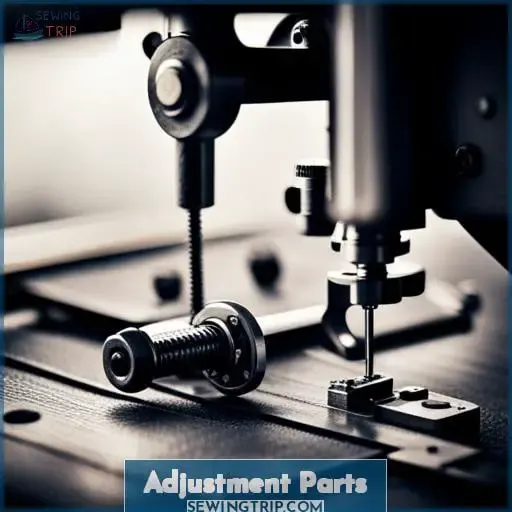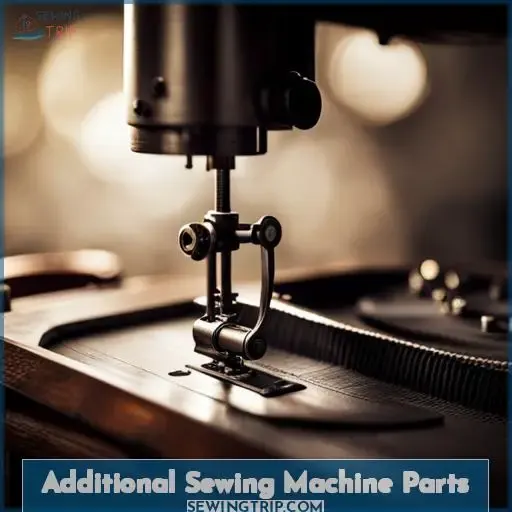This site is supported by our readers. We may earn a commission, at no cost to you, if you purchase through links.
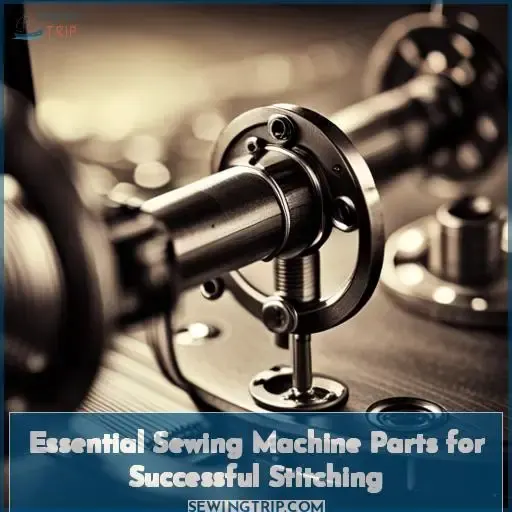 Like a tailor crafting a bespoke suit, your sewing machine stitches dreams into reality.
Like a tailor crafting a bespoke suit, your sewing machine stitches dreams into reality.
As you feed fabric through its mechanical heart, a menagerie of parts dance in precision:
- Needle piercing cloth
- Bobbin weaving thread
- Presser foot holding fabric taut
Together, these essential sewing machine parts empower creators, helping them birth cherished items with soul-nourishing potential.
What will you stitch today?
Table Of Contents
Key Takeaways
- Bobbin and bobbin case, needle and presser foot, throat plate and feed dogs are main sewing machine components that guide and move the fabric.
- The presser foot and feed dogs are important for keeping fabric under control as you sew.
- Key adjustment parts like the stitch selector and hand wheel allow you to set the machine for different types of stitches and control the needle position.
- Additional parts such as the spool pin and bobbin winder hold the thread and allow you to wind bobbins needed for sewing.
Main Sewing Machine Components
As you prepare to stitch, becoming familiar with some key parts will set you up for success.
Essential components include:
- Bobbin and bobbin case
- Needle and presser foot
- Throat plate and feed dogs
Understanding the role these play is crucial before threading your machine and starting any project.
Bobbin and Bobbin Case
As you sew, the bobbin and bobbin case work together to supply thread for the underside of the stitch, with the bobbin holding the thread and the bobbin case securing the bobbin in place within the machine.
Use only manufacturer-recommended bobbins for your machine.
Keep the bobbin case clean and lint-free.
Replace damaged bobbin cases immediately.
The knowledgeable sewist understands the critical role of the bobbin and bobbin case in successful stitching. Proper bobbin compatibility, winding techniques, and maintenance help avoid frustrating tangles or breaks that disrupt creative projects.
By troubleshooting issues promptly, the bobbin and feed dogs can continue smoothly guiding thread to form beautiful seams.
Needle and Presser Foot
You’ll then encounter the needle and presser foot, essential parts that work together to guide fabric under the needle for stitching. Proper needle maintenance and choosing the right presser foot option help ensure stitch precision and fabric grip while regulating thread tension.
| Part | Function | Considerations |
|---|---|---|
| Needle | Pierces fabric to create stitch | Size, type for fabric |
| Presser Foot | Holds fabric in place | Pressure, stability |
| Needle Clamp | Holds needle securely | Tightness, attachments |
Throat Plate and Feed Dogs
You’d better insert your fabric between the throat plate and feed dogs to maintain even stitching.
The throat plate sits below the needle and has guidelines for seam allowances.
Feed dogs are tooth-like mechanisms under the plate that grip fabric and precisely guide it under the needle.
They regulate stitch length by controlling fabric movement as you sew.
Don’t manually push or pull the material.
The throat plate and feed dogs work together in a sewing machine to direct fabric for neat, uniform stitches.
Understanding their coordination leads to success.
Fabric Control Parts
Now, let’s talk about two important fabric control parts of your sewing machine: the presser foot and the feed dogs.
The presser foot is responsible for pressing and holding down the fabric as it moves under the needle, providing stability during sewing.
The feed dogs, on the other hand, are teeth-like metal underneath the throat plate that grab onto the fabric and push it forward as you sew.
Understanding how these two parts work together will help ensure smooth and precise stitching results while maintaining control over your fabrics.
Presser Foot
The presser foot presses and holds the fabric down onto the feed dogs as you sew.
This component provides stability and traction to move the material under the needle.
Innovations like adjustable presser feet allow more precision on different fabrics.
Learn techniques to properly position your pressure foot so it holds fabric flat without puckering seams.
Troubleshoot issues like skipping stitches by checking presser foot pressure.
Accessories like Teflon-coated feet smoothly feed slippery synthetics.
Maintain grip with regular cleaning or replace when excessively worn.
Adjustments ensure your sewing machine’s presser foot works reliably during stitching.
Feed Dogs
Frequently, your feed dogs grab and push the fabric back as they go up, feeding material precisely under the needle.
As an essential component for precision stitching, feed dogs have the following key functions:
- Grab onto fabric with small teeth to move it through the machine.
- Push fabric back after going up to regulate stitch length.
- Gets lowered for specialty techniques like buttonholes.
- Prevents manual pushing or pulling for uniform fabric movement.
With proper understanding and use, feed dogs enable excellent stitch control and precision for all sewing projects, from delicate silks to heavy denim.
Adjusting settings correctly prevents uneven fabric feeding.
So whether constructing a complex garment or repairing a tear, keep your feed dogs cleared and calibrated.
Precise stitching relies on their consistent upward and backward motion to grip fabric and regulate each stitch.
Adjustment Parts
As you become familiar with your machine, you’ll want to adjust settings to suit your project.
Two key parts that allow adjustment are the stitch selector and hand wheel.
We’ll look closely at how these parts can help you optimize stitching.
Stitch Selector
By adjusting the stitch selector, you’re choosing various stitch lengths and patterns for your project.
As an avid sewer, I recommend playing with the stitch selector to unleash your creativity.
Try varying stitch lengths on different weight fabrics – a longer stitch on lighter cottons prevents puckering.
When working with thicker denim or canvas, select a shorter stitch so the fabric feeds smoothly.
Consult your machine’s stitch guide, often printed beside the selector, to pick decorative stitches like zigzags or satin stitches to embellish hems and edges.
If skipping stitches occurs, clean lint from the feed dogs and rethread the machine.
With some practice using the stitch selector, you’ll have the skills to customize patterns and stitch beautiful, creative projects.
Hand Wheel
Your hand wheel lets you manually turn the machine when working with thick fabrics or for precise stitch placement.
The handwheel gives you greater control over stitch length and placement than the foot pedal.
Grasping the wheel to turn it engages a gear that raises and lowers the needle bar.
Check your owner’s manual for handwheel operation specifics, as placement varies.
When not using the handwheel, ensure it turns freely for proper machine function.
Over time, lint and debris accumulate internally, requiring cleaning.
The handwheel evolved from earlier treadle mechanisms.
While less tiring, losing nuanced speed control tradeoffs occurred.
Overall though, incorporating handwheel functionality improved sewing machine usability and commercial viability.
Additional Sewing Machine Parts
You’ll find two other key parts that enable successful stitching:
- The spool pin holds the thread spool in place.
- The bobbin winder takes thread off the spool and winds it onto empty bobbins for the underside of your stitches.
Both must function properly to keep your thread supplied during sewing.
Spool Pin
Your spool pin holds the thread spool steadily so you can sew without interruption.
This component, which controls thread direction with horizontal or vertical configuration, is essential for continuous thread supply.
Vertical spool pins allow thread to unwind directly downwards, while horizontal pins require an additional thread guide.
Certain models have two spool pins to accommodate multiple thread spools.
High-end machines may include specialty spool pin types like self-winding stands and auto-stop functions when thread runs out.
Proper thread control prevents tangled messes, so utilize spool caps, tension discs, and quality thread.
With a quality spool pin correctly set up, you can focus on creative sewing rather than troubleshooting thread issues.
Bobbin Winder
The bobbin winder is another part you’ll use to keep your sewing machine running smoothly.
Wind bobbins efficiently by guiding the thread evenly across the spool as it fills.
Load wound bobbins by following any loading direction indicators inside the bobbin compartment.
Clean the bobbin winder with a small brush when lint accumulates. Dust slows the winding speed over time.
As an experienced sewer, I rely on proper bobbin winding technique and maintenance practices for smooth stitching. Guiding the thread back and forth when filling the bobbin prevents tangling underneath as you sew.
Regularly removing lint preserves winding efficiency. Proper loading also prevents messy stitches. Follow these bobbin winder insights, and your projects will have neatly finished seams.
Frequently Asked Questions (FAQs)
How often should I get my sewing machine serviced?
Get your sewing machine serviced every 12 to 18 months by an authorized dealer to keep it running smoothly.
This preventative maintenance helps ensure proper tension, lubrication, timing, and adjustments for optimal stitch quality and performance.
Following the manufacturer’s recommendations helps prevent issues before they arise.
What sewing machine accessories are must-haves for beginners?
- Start with a basic sewing kit.
-
Essentials include:
- Fabric scissors
- Seam ripper
- Hand needles
- Thread
- Pins and pincushion
- Iron
- Measuring tape
- Seam gauge
-
Easy add-ons are:
- Bias tape maker
- Zipper foot
- Hemmer foot
- Piping foot
- Build your tool collection as your skills and interests grow.
How do I clean my sewing machine and prevent lint buildup?
Clean lint daily by lowering the needle and feed dogs.
Use a small brush to gently sweep debris and dust from the bobbin area, under the presser foot, and around the feed dogs.
Periodically use compressed air to blow away trapped lint in crevices.
Apply a drop of sewing machine oil to prevent rust if moisture gets trapped.
What’s the difference between mechanical and computerized sewing machines?
Mechanical sewing machines rely solely on physical mechanisms and manual adjustments, providing more control but generally less convenience and functionality.
Computerized sewing machines incorporate electronic systems and automated functions, enabling easier operation, more stitch options, built-in guides, and quicker setup.
However, they introduce complexity and typically higher costs.
How do I choose the right type of needle for my sewing project?
Choose needles based on your fabric type:
- For delicate fabrics like silk, use sharp needles.
- For denim and canvas, pick thicker needles.
Match the needle size to thread thickness too.
Testing on fabric scraps ensures proper stitch formation without damaging fabrics or needles.
Conclusion
Astonishingly, a sewing machine contains over 250 parts working in harmony.
As you discover each component’s purpose, from feed dogs pulling fabric to bobbins weaving thread, remember that these parts empower creators.
Let essential elements like the needle, presser foot, and tension discs guide you onward, stitching dreams into reality one masterpiece at a time.
What’ll your capable machine help manifest next?

